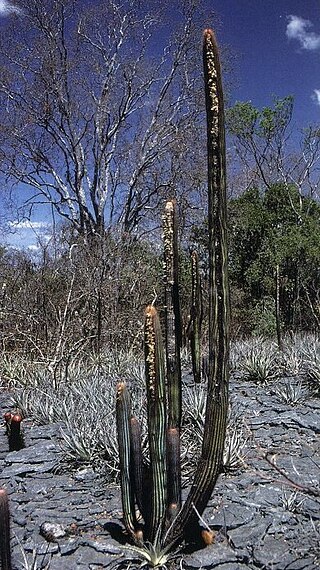
Gymnocalycium, commonly called chin cactus, is a genus of about 70 South American species of cactus. The genus name Gymnocalycium refers to the flower buds bearing no hair or spines. In a 2023 classification of the tribe Cereeae, it was placed as the only genus in the subtribe Gymnocalyciinae, having formerly been placed in the subtribe Rebutiinae.

Melocactus, also known as the Turk's head cactus, Turk's cap cactus, or Pope's head cactus, is a genus of cactus with about 30–40 species. They are native to the Caribbean, western Mexico through Central America to northern South America, with some species along the Andes down to southern Peru, and a concentration of species in northeastern Brazil.

Pediocactus is a genus of cacti native to the Western United States. The genus comprises between 6 and 11 species, depending upon the authority. Species of this genus are referred to as hedgehog cacti, though that name is also applied to plants from the genera Echinocereus and Echinopsis. Species may also be referred to as pincushion cacti, a common name which is also applied to other genera.

Disocactus is a genus of epiphytic cacti in the tribe Hylocereeae found in Central America, the Caribbean and northern South America. It should not be confused with Discocactus, which is a different genus.

Neowerdermannia is a genus of South American cacti.

Espostoopsis is a monotypic genus of cactus containing the single species Espostoopsis dybowskii. The generic name is formed from Greek opsis meaning "view", referring to its resemblance to the genus Espostoa, with which it is often confused. The plant is only known from northern Bahia, Brazil.

Oreocereus is a genus of cacti, known only from high altitudes of the Andes. Its name means "mountain cereus", formed from the Greek prefix oreo- and the Neo-Latin cereus, meaning wax or torch.

Brasiliopuntia is a genus in the cactus family, Cactaceae. It contains only one species, Brasiliopuntia brasiliensis.

Micranthocereus dolichospermaticus is a species of plant in the family Cactaceae. It is endemic to Brazil, where it is confined to the states of Bahia and Minas Gerais. Its natural habitat is rocky areas. It is threatened by habitat loss.

Micranthocereus violaciflorus is a species of plant in the family Cactaceae. It is endemic to Brazil.

Harrisia bonplandii is a species of cactus. The cactus plants in the Gran Chaco are generally called tuna and this specific variety reina de la noche. Fruits and roots are edible and well known to the native nations of the Gran Chaco.

Lophocereus marginatus is a species of plant in the family Cactaceae. It is sometimes called Mexican fencepost cactus.

Cipocereus bradei is a species of cactus. It is endemic to the state of Minas Gerais in Brazil. It is threatened by habitat loss.

Melocactus caroli-linnaei is a cactus found in Jamaica. When mature it is columnar, up to 1 m (3.3 ft) high. Like all species of Melocactus, it forms a "cephalium" when mature – a dense mass of areoles covered with wool and spines at the tip of the stem. Flowers are produced only from the cephalium.

Gymnocalycium denudatum is a species of Gymnocalycium from Brazil to Argentina.

Discocactus bahiensis is a species of Discocactus from Brazil.

Melocactus bahiensis is a species of Melocactus found in Bahia, Brazil.

Acanthocalycium leucanthum is a species of flowering plant in the cactus family Cactaceae from Argentina.
Discocactus pseudoinsignis is a species of Discocactus found in Brazil.

Micranthocereus purpureus is a species of Micranthocereus found in Brazil.






























